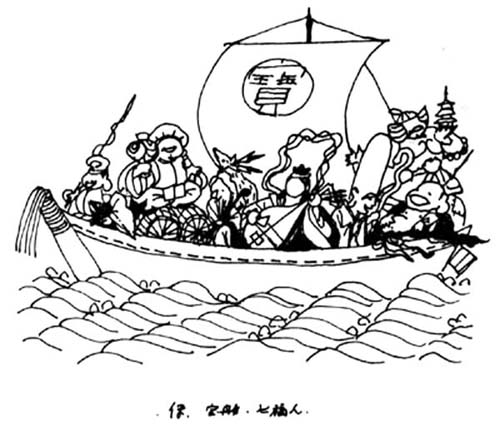|
||
 |
||

(C)2001 Japanese Architecture and Art Net Users System. No reproduction or republication without written permission.
掲載のテキスト・写真・イラストなど、全てのコンテンツの無断複製・転載を禁じます。
|
||||||
| takarabune 宝船 | ||||||
| KEY WORD : art history / iconography | ||||||
| A sailboat, hokakebune 帆掛船 at full sail, loaded with rice bushels and treasures takara 宝, often bearing the seven gods of good fortune *shichifukujin 七福神. Paintings or prints of this boat usually include a special and auspicious poem which reads the same when read backwards from the end; nagakiyo no/ tou no nemuri no/ mina mezame/ naminori fune no/ oto no yokikana 長き夜の/ 遠の眠りの/ 皆目覚め/ 波乗り船の/ 音のよきかな [Awakening from a deep sleep after a long night, I seem to hear the sweet sound of a boat sailing through the waves]. The Chinese character, baku 獏, a Chinese imaginary animal which is thought to devour (i.e. prevent) nightmares, is sometimes found written on the sail . Often auspicious cranes and tortoises are depicted in the sky and the sea. Although the origin of treasure-boat paintings is not clear, one Edo period record indicates that they were started in the Muromachi period. According to a different source, they were originally imperial gifts to high-ranking courtiers in celebration of the New Year. It became a popular custom among common people in the Edo period to place takarabune pictures under one's pillow on the second night of the New Year to induce auspicious dreams and resulting good fortune. In the event of a bad dream, one custom was to set the painting adrift in the river or sea to forestall bad luck. Simple, uncolored woodblock prints of the treasure-boats came to be sold on the streets by roving vendors from the early 18c until the mid-Meiji period. There are numerous examples of the treasure- boat done as inexpensive woodblock prints that still exist. However, there are also fine hanging scrolls painted usually in ink by first-rate artists of the Edo period, such as Ogata Kourin 尾形光琳 (1659-1716) and Tani Bunchou 谷文晁 (1763-1840). *Ukiyo-e 浮世絵 print artists also introduced variations such as *mitate-e 見立絵 of the seven gods of good fortune replaced by seven beauties or by popular *kabuki 歌舞伎 actors of the day. | ||||||
 |
||||||
| REFERENCES: | ||||||
| EXTERNAL LINKS: | ||||||
| NOTES: | ||||||
(C)2001 Japanese Architecture and Art Net Users System. No reproduction or republication without written permission. 掲載のテキスト・写真・イラストなど、全てのコンテンツの無断複製・転載を禁じます。 |
||||||